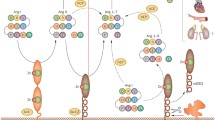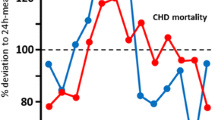Abstract
Activation of the renin–angiotensin system increases the risk of atherohrombotic events in hypertensive patients. This relationship may be explained by multiple mechanisms, including effects on platelet function and on fibrinolysis. There is substantial evidence that angiotensin-converting enzyme (ACE) inhibitors may exert antithrombotic effects by enhancing the bradykinin-dependent release of tissue plasminogen activator (t-PA) while reducing the angiotensin-dependent production of its natural inhibitor PAI-1, thus improving vascular fibrinolytic balance. Recent studies suggest that angiotensin (II) type 1 (AT1) receptor antagonists inhibit the effects of prothrombotic prostanoids. The antithrombotic effects of agents that block the RAS may contribute to their vasculoprotective properties.
Similar content being viewed by others
References
Alderman MH, Madhavan S, Ooi WL, Cohen H, Sealey JE, Laragh JH. Association of the renin-sodium profile with the risk of myocardial infarction in patients with hypertension. N Engl J Med 1991;324:1098-1104.
Alderman MH, Ooi WL, Cohen H, Madhavan S, Sealey JE, Laragh JH. Plasma renin activity: a risk factor for myocardial infarction in hypertensive patients. Am J Hypertens 1997;10:1-8.
Meade TW, Cooper JA, Peart WS. Plasma renin activity and ischemic heart disease. N Engl J Med 1993;329:616-619.
Chobanian AV, Haudenschild CC, Nickerson C, Drago R. Antiatherogenic effect of captopril in the Watanabe heritable hyperlipidemic rabbit. Hypertension 1990;15:327-331.
Chobanian AV, Haudenschild CC, Nickerson C, Hope S. Trandolapril inhibits atherosclerosis in the Watanabe heritable hyperlipidemic rabbit. Hypertension 1992;20:473-477.
Aberg G, Ferrer P. Effects of captopril on atherosclerosis in cynomolgus monkeys. J Cardiovasc Pharmacol 1990;15: S65-S72.
Schuh JR, Blehm DJ, Frierdich GE, McMahon EG, Blaine EH. Differential effects of renin-angiotensin system blockade on atherogenesis in cholesterol-fed rabbits. J Clin Invest 1993;91:1453-1458.
Pfeffer MA, Braunwald E, Moye LA, et al. Effect of captopril on mortality and morbidity in patients with left ventricular dysfunction after myocardial infarction. Results of the survival and ventricular enlargement trial. The SAVE Investigators. N Engl J Med 1992;327:669-677.
Yusuf S, Pepine CJ, Garces C, et al. Effect of enalapril on myocardial infarction and unstable angina in patients with low ejection fractions. Lancet 1992;340:1173-1178.
Sealey JE, Laragh HJ. The renin-angiotensin-aldosterone system for normal regulation of blood pressure and sodium and potassium homeostasis. In Laragh HJ, Brenner BM (eds), Hypertension: Pathophysiology, Diagnosis and Treatment. New York: Raven Press, 1990:1287-1317.
Erdos EG, Skidgel RA. The angiotensin I-converting enzyme. Lab Invest 1987;56:345-348.
Timmermans PB, Chiu AT, Herblin WF, Wong PC, Smith RD. Angiotensin II receptor subtypes. Am J Hypertens 1992;5:406-410.
Ward PE, Russell JS, Vaghy PL. Angiotensin and bradykinin metabolism by peptidases identified in skeletal muscle. Peptides 1995;16:1073-1078.
Collen D, Lijnen HR. The fibrinolytic system in man. Crit Rev Oncol Hematol 1986;4:249-301.
Sprengers ED, Kluft C. Plasminogen activator inhibitors. Blood 1987;69:381-387.
Loskutoff DJ, Schleef RR. Plasminogen activators and their inhibitors. Methods Enzymol 1988;163:293-302.
Vaughan DE, Rouleau J-L. Ridker PM, Arnold JMO, Menapace FJ, Pfeffer MA. Effects of ramipril on plasma fibrinolytic balance in patients with acute anterior myocardial infarction. Circulation 1997;96:442-447.
Hamsten A, Wiman B, de Faire U, Blomback M. Increased plasma levels of a rapid inhibitor of tissue plasminogen activator in young survivors of myocardial infarction. N Engl J Med 1985;313:1557-1563.
Hamsten A, de Faire U, Walldius G, et al. Plasminogen activator inhibitor in plasma: risk factor for recurrent myocardial infarction. Lancet 1987;2:3-9.
Meade TW, Ruddock V, Stirling Y, Chakrabarti R, Miller GJ. Fibrinolytic activity, clotting factors, and long-term incidence of ischaemic heart disease in the Northwick Park Heart Study. Lancet 1993;342:1076-1079.
Schneiderman J, Sawdey MS, Keeton MR, et al. Increased type 1 plasminogen activator inhibitor gene expression in atherosclerotic human arteries. Proc Nat Acad Sci the U S A 1992;89:6998-7002.
Lupu F, Bergonzelli GE, Heim DA, et al. Localization and production of plasminogen activator inhibitor-1 in human healthy and atherosclerotic arteries. Arterioscler Thromb 1993;13:1090-100.
Robbie LA, Booth NA, Brown AJ, Bennett B. Inhibitors of fibrinolysis are elevated in atherosclerotic plaque. Arterioscler Thromb Vasc Biol 1996;16:539-545.
Alexander CM, Werb Z. Proteinases and extracellular matrix remodeling. Curr Opin Cell Biol 1989;1:974-982.
Lyons RM, Gentry LE, Purchio AF, Moses HL. Mechanism of activation of latent recombinant transforming growth factor beta 1 by plasmin. J Cell Biol 1990;110:1361-1367.
Padro T, Emeis JJ, Steins M, Schmid KW, Kienast J. Quantification of plasminogen activators and their inhibitors in the aortic vessel wall in relation to the presence and severity of atherosclerotic disease. Arterioscler Thromb Vas Biol 1995;15:893-902.
Lupu F, Heim DA, Bachmann F, Hurni M, Kakkar VV, Kruithof EK. Plasminogen activator expression in human atherosclerotic lesions. Arterioscler Thromb Vasc Biol 1995; 15:1444-1455.
Grainger DJ, Kirschenlohr HL, Metcalfe JC, Weissberg PL, Wade DP, Lawn RM. Proliferation of human smooth muscle cells promoted by lipoprotein(a). Science 1993;260:1655- 1658.
Grainger DJ, Kemp PR, Metcalfe JC, et al. The serum concentration of active transforming growth factor-beta is severely depressed in advanced atherosclerosis [see comments]. Nat Med 1995;1:74-79.
Xiao Q, Danton MJ, Witte DP, et al. Plasminogen deficiency accelerates vesselwall disease in mice predisposed to atherosclerosis. Proc Nat Acad Sci U S A1997;94:10335-10340.
van Leeuwen RT, Kol A, Andreotti F, Kluft C, Maseri A, Sperti G. Angiotensin II increases plasminogen activator inhibitor type 1 and tissue-type plasminogen activator messenger RNA in cultured rat aortic smooth muscle cells. Circulation 1994;90:362-368.
Vaughan DE, Lazos SA, Tong K. Angiotensin II regulates the expression of plasminogen activator inhibitor-1 in cultured endothelial cells. A potential link between the renin- angiotensin system and thrombosis. J Clin Invest 1995;95: 995-1001.
Feener EP, Northrup JM, Aiello LP, King GL. Angiotensin II induces plasminogen activator inhibitor-1 and-2 expression in vascular endothelial and smooth muscle cells. J Clin Invest 1995;95:1353-1362.
Kerins DM, Hao Q, Vaughan DE. Angiotensin induction of PAI-1 expression in endothelial cells is mediated by the hexapeptide angiotensin IV. J Clin Invest 1995;96:2515- 2520.
Oikawa T, Freeman M, Lo W, Vaughan DE, Fogo A. Modulation of plasminogen activator inhibitor-1 in vivo: a new mechanism for the anti-fibrotic effect of renin-angiotensin inhibition. Kidney Int 1997;51:164-172.
Yamashita M, Darlington DN, Weeks EJ, Jones RO, Gann DS. Plasminogen activator inhibitor-1 rises after hemorrhage in rats. Am J Physiol 1995;268:E1065-E1069.
Hamdan AD, Quist WC, Gagne JB, Feener EP. Angiotensin-converting enzyme inhibition suppresses plasminogen activator inhibitor-1 expression in the neointima of balloon-injured rat aorta. Circulation 1996;93:1073-1078.
Pederson OD, Gram J, Bagger H, Keller N, Jespersen CT. Regulation of tissue-type plasminogen activator mediated fibrinolysis by plasminogen activator inhibitor type-1 in patients with ischemic heart disease: possible unfavorable effects of diuretics. Coronary Artery Dis 1994;5:617-623.
Vaughan DE, Rouleau JL, Pfeffer MA. Role of the fibrinolytic system in preventing myocardial infarction. Eur Heart J 1995;16:31-36.
Brown NJ, Vaughan DE. ACE inhibition decreases PAI-1 in the setting of an activated RAS. Hypertension 1997;30:514.
Ding YA, Kenyon CJ, Semple PF. Regulation of platelet receptors for angiotensin II in man. J Hypertens 1985;3: 209-212.
Crabos M, Bertschin S, Buhler FR, et al. Identification of AT1 receptors on human platelets and decreased angiotensin II binding in hypertension. J Hypertens Suppl 1993; 11:S230-S231.
Ding YA, MacIntyre DE, Kenyon CJ, Semple PF. Potentiation of adrenaline-induced platelet aggregation by angiotensin II. Thromb Haemost 1985;54:717-720.
Rajagopalan S, Kurz S, Munzel T, et al. Angiotensin II-mediated hypertension in the rat increases vascular superoxide production via membrane NADH/NADPH oxidase activation. Contribution to alterations of vasomotor tone. J Clin Invest 1996;97:1916-923.
Laursen JB, Rajagopalan S, Galis Z, Tarpey M, Freeman BA, Harrison DG. Role of superoxide in angiotensin II-induced but not catecholamine-induced hypertension [see comments]. Circulation 1997;95:588-593.
Maeso R, Rodrigo E, Munozgarcia R, et al. Losartan reduces constrictor responses to endothelin-1 and the thromboxane A2 analogue in aortic rings from spontaneously hypertensive rats-role of nitric oxide. J H ypertens 1997;15:1677- 1684.
Li P, Ferrario CM, Brosnihan KB. Nonpeptide angiotensin II antagonist losartan inhibits thromboxane A2-induced contractions in canine coronary arteries. J Pharmacol Exp Therapeut 1997;281:1065-070.
Li P, Ferrario CM, Brosnihan KB. Losartan inhibits thromboxane A2-induced platelet aggregation and vascular constriction in spontaneously hypertensive rats. Circulation 1997;96:I–102.
Liu EC, Hedberg A, Goldenberg HJ, Harris DN, Webb ML. DuP 753, the selective angiotensin II receptor blocker, is a competitive antagonist to human platelet thromboxane A2/ prostaglandin H2 (TP) receptors. Prostaglandins 1992;44: 89-99.
Smith D, Gilbert M, Owen WG. Tissue plasminogen activator release in vivo in response to vasoactive agents. Blood 1985;66:835-839.
Brown NJ, Nadeau JH, Vaughan DE. Selective stimulation of tissue-type plasminogen activator (t-PA) in vivo by infusion of bardykinin. Thromb Haemost 1997;77:522-525.
Wright RA, Flapan AD, Alberti KG, Ludlam CA, Fox KA. Effects of captopril therapy on endogenous fibrinolysis in menwith recent, uncomplicated myocardial infarction. J Am Coll Cardio 1994;24:67-73.
Jansson JH, Boman K, Nilsson TK. Enalapril related changes in the fibrinolytic system in survivors of myocardial infarction. Eur J Clin Pharmacol 1993;44:485-488.
Pfeffer MA, Greaves SC, Arnold JM, et al. Early versus delayed angiotensin-converting enzyme inhibition therapy in acute myocardial infarction. The healing and early after-load reducing therapy trial. Circulation 1997;95:2643-2651.
Soejima H, Ogawa H, Yasue H, Suefuji H, Kaikita K, Nishiyama K. Effects of imidapril therapy on endogenous fibrinolysis in patients with recent myocardial infarction. Clin Cardiol 1997;20:441-445.
Seljeflot I, Moan A, Kjeldsen S, Sandvik E, Arnesen H. Effect of angiotensin II receptor blockade on fibrinolysis during acute hyperinsulinemia in patients with essential hypertension. Hypertension 1996;27:1299-1304.
Author information
Authors and Affiliations
Rights and permissions
About this article
Cite this article
Brown, N.J., Vaughan, D.E. Role of Angiotensin II in Coagulation and Fibrinolysis. Heart Fail Rev 3, 193–198 (1999). https://doi.org/10.1023/A:1009757416302
Issue Date:
DOI: https://doi.org/10.1023/A:1009757416302




